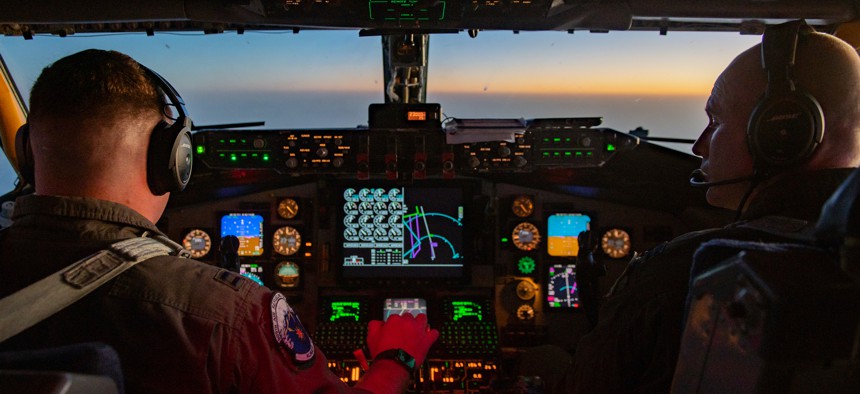
U.S. Air Force Capts. Kyle Weinell, left, and Trevor Gardener, 909th Air Refueling Squadron pilots, fly a KC-135 before nighttime aerial refueling over the Pacific Ocean, April 14, 2022. U.S. Air Force / Airman 1st Class Cesar J. Navarro
The Air & Space Brief: No more ASAT tests; A final Doolittle toast; Aviator cancers
Welcome to the Defense One Air and Space newsletter. Here are our top stories this week:
No more U.S. ASAT Tests: The U.S. will no longer conduct anti-satellite tests due to the dangerous amount of space debris they can generate—and the U.S. government hopes other countries will follow suit, Vice President Kamala Harris announced Monday. In November, Russia fired a missile at one of its own defunct satellites in orbit about 480 kilometers above the Earth—the test created a debris field of more than 1,600 objects, putting both China’s space station and the international space station at risk. But ending the tests could put the U.S. at a disadvantage, said Rep. Mike Turner, R-Ohio, ranking member of the House Armed Services subcommittee on strategic forces. “Unilaterally stripping ourselves of the option to increase our capabilities in space, places our national security at risk and weakens our ability to respond to increased Russian and Chinese threats,” Turner said in a statement.
The Last Doolittle Raider: The U.S. Army Air Forces’ 80 Doolittle Raiders became instant heroes on April 18, 1942, when they launched 16 B-25 Mitchell bombers off the USS Hornet in a suprise attack on Tokyo. In 1946, they held their first reunion, sharing a bottle of 1896 Hennessy VS cognac in honor of the birth year of mission leader Lt. Col. Jimmy Doolittle.
Every Doolittle Raider had a silver goblet engraved with his name. At the annual reunions that followed, survivors would raise a toast of Hennessy to Raiders who’d passed the year before, and then turn those Raiders’ goblets upside-down in their velvet-lined case. On Monday, the final goblet was turned.
Aviator cancers: Just like the fighter pilots they supported, many troops who fueled, armed, and maintained warplanes have suffered from cancer or seen their former colleagues diagnosed with the disease. There’s no data yet on how many ground crew members have gotten sick, but a new bill introduced Thursday would require the Department of Veterans Affairs to identify the cancer incidence in the entire aviation community, as well as what toxins they faced, and whether there could be a link to their illnesses.
Long March remnants? India is examining a very large ring that fell in its rural western region earlier this month, and scientists believe it could be part of China’s Long March 3B rocket that was launched into space in February 2021, SpaceNews.com reported Monday.
Sign up to get The Air & Space Brief every Tuesday from Tara Copp, Defense One’s Senior Pentagon Reporter. On April 19, 1971, the Soviet Union launched the world’s first space station.
 From Defense One
From Defense One
Air Force Raises a Last Glass to the Final Doolittle Raider // Tara Copp
The children of Lt. Col. Dick Cole say farewell to the last of 80 men who flew the historic 1942 mission.
Aviator Cancer Bill Would Push VA to Study Toxins Air Crews Faced, Assess Links to Cancers // Tara Copp
Ground crew and flight crew cancers would be reviewed. So would the fuels, chemicals, and emissions they were exposed to.
Defense Department Sets Out to Build Miniature Nuclear Reactor, Again // Patrick Tucker
Changing politics and military goals suggest that this time, mobile nuclear power could go mainstream.





